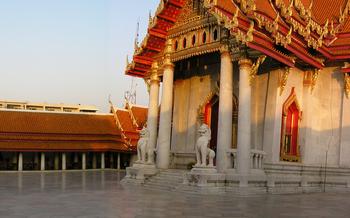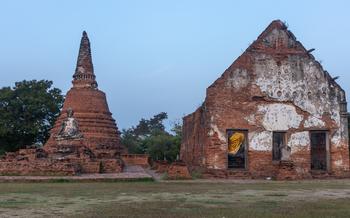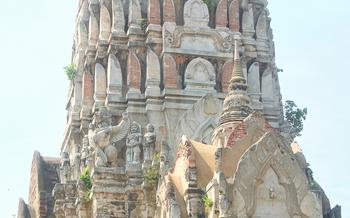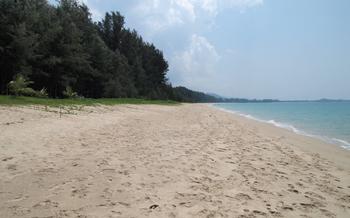
Wat Sriwaree Noi
- Location and Accessibility
- Exploring the Temple Grounds
- The Grand Buddha Image
- The Ubosot (Ordination Hall)
- The Sala Kan Parian (Prayer Hall)
- The Bell Tower and Drum Tower
- The Temple Museum
- The Temple Fair and Festivals
- Local Beliefs and Customs
- Photography and Videography
- Accommodation and Dining Options
- Insider Tip: Unveiling the Hidden Gem
Location and Accessibility
Wat Sriwaree Noi is conveniently located in the Bang Phli Yai District, just a short distance from the city center of Samut Prakan. The exact address is 110 Moo 10, Bang Phli Yai Subdistrict, Bang Phli Yai District, Samut Prakan 10180. To get to the temple from Bangkok, visitors can take a taxi or a bus bound for Samut Prakan. The journey usually takes about an hour, depending on traffic conditions. Once in Samut Prakan, visitors can ask for directions to Wat Sriwaree Noi from locals or use a navigation app like Google Maps. There is ample parking space available within the temple grounds, making it easy for visitors to park their vehicles.
Exploring the Temple Grounds
The Wat Sriwaree Noi temple complex is a treasure trove of architectural wonders and spiritual significance, beckoning visitors to embark on a journey of discovery. The layout of the temple is designed to instill a sense of serenity and reverence, with lush gardens, serene ponds, and intricate structures adorning the grounds.
As you enter the temple, your eyes will be immediately drawn to the Grand Buddha Image, the towering centerpiece of the complex. Standing tall and majestic, this awe-inspiring statue exudes an aura of tranquility and spirituality. Take a moment to admire its intricate details and pay your respects to the revered figure.
Other notable structures within the temple include the Ubosot (Ordination Hall), a sacred space where monks undergo ordination ceremonies. Its elegant design, adorned with intricate murals and carvings, reflects the temple's rich history and spiritual significance. The Chedi (Reliquary Stupa), with its towering spire, is believed to contain sacred relics and serves as a reminder of the temple's religious importance.
Visitors are welcome to explore the temple grounds, marveling at the beautiful architecture and serene ambiance. However, certain areas may be restricted or closed during religious ceremonies or special events. It is essential to respect the sanctity of the temple and adhere to any guidelines or instructions provided by the temple authorities.
The Grand Buddha Image
At the heart of Wat Sriwaree Noi, enshrined within the Ubosot, lies a majestic Buddha image that exudes an aura of serenity and reverence. Known as the Luang Pho To, this colossal statue stands at an impressive height of 18 meters, making it one of the largest Buddha images in Samut Prakan. Cast in bronze with intricate gold leaf detailing, the image radiates a warm and inviting glow, captivating the hearts of devotees and visitors alike.
The Luang Pho To holds deep religious and spiritual significance for Buddhists. It is believed to date back to the Ayutthaya period, a time of great prosperity and cultural flourishing in Thailand. The image is said to have been created by a skilled artisan who dedicated his life to crafting sacred Buddhist sculptures.
For devotees, the Luang Pho To represents a symbol of hope, compassion, and protection. They flock to the temple from near and far to pay homage to the image, seeking blessings and guidance in their lives. The Buddha's serene expression and intricate features inspire a sense of peace and tranquility, inviting visitors to reflect on their own spiritual journeys.
The Ubosot (Ordination Hall)
The Ubosot, or ordination hall, at Wat Sriwaree Noi stands as a testament to the temple's architectural grandeur and religious significance. This sacred building serves as the primary venue for important ceremonies and rituals, including ordinations, chanting sessions, and meditation practices.
The Ubosot's design exudes a sense of serenity and reverence, with its elegant lines and intricate details. The exterior walls are adorned with intricate carvings and bas-reliefs depicting scenes from Buddhist mythology and history, inviting visitors to delve into the rich tapestry of Thailand's spiritual heritage.
Stepping inside the Ubosot, visitors are greeted by a breathtaking sight. The hall's interior is adorned with vibrant murals and paintings that narrate the life of Buddha, conveying his teachings and guiding principles. These exquisite artworks serve as a visual representation of the temple's devotion to the Buddha's teachings and provide visitors with a glimpse into the profound spiritual journey that unfolds within these walls.
The Ubosot's central feature is the Buddha image, seated serenely on a raised platform. The image exudes an aura of peace and tranquility, inviting visitors to pause and reflect on the teachings of the Buddha. The walls of the Ubosot are lined with rows of wooden benches, where monks and laypeople gather for chanting sessions, meditation practices, and other religious ceremonies.
The Ubosot at Wat Sriwaree Noi is not only a sacred space for religious observances but also a place of profound spiritual connection and reflection. Visitors are welcome to enter the Ubosot and experience the tranquility and serenity that permeate the air. However, it is important to maintain a respectful demeanor and adhere to the temple's customs and etiquette, ensuring that the sanctity of this sacred space is preserved.
The Sala Kan Parian (Prayer Hall)
Located at the heart of Prayer Hall, holds a significant place in the temple's religious and spiritual life. Constructed in a traditional Thai architectural style, the Sala Kan Parian exudes a serene and tranquil atmosphere. It serves as a dedicated space for devotees to gather, offer prayers, and seek blessings from the sacred Buddha images enshrined within.
The interior of the Prayer Hall is adorned with intricate murals and paintings depicting scenes from Buddhist mythology and folklore. These vibrant artworks create a visually captivating backdrop for the devout as they engage in their prayers and devotions. The hall is also equipped with comfortable seating arrangements, allowing visitors to sit in contemplation and immerse themselves in the sacred atmosphere.
During special ceremonies and festivals, the Sala Kan Parian transforms into a vibrant hub of religious activity. Devotees from near and far come together to participate in chanting, meditation sessions, and other spiritual practices. The air fills with the melodious sounds of prayers and the gentle tinkling of bells, creating a truly enchanting and immersive experience for all present.
It is important to note that the Prayer Hall is a sacred space, and visitors are expected to observe proper etiquette and guidelines during their visit. This includes maintaining silence, removing shoes before entering, and dressing modestly. By adhering to these simple rules, visitors can show their respect for the religious customs and practices of the temple.
The Bell Tower and Drum Tower
The bell tower and drum tower stand tall within the temple complex, serving as important religious and cultural structures. The bell tower, also known as the Hor Rakhang in Thai, is primarily used to signal the time for temple activities. The bell inside the tower is struck with a wooden mallet, creating a resounding sound that reverberates throughout the temple grounds. The drum tower, known as the Hor Kong in Thai, serves a similar purpose. The large drum within the tower is struck with a wooden mallet during ceremonies and rituals, producing a deep and rhythmic sound that complements the bell.
These structures not only have functional significance but also hold cultural and religious value. The sound of the bell and drum is believed to awaken the spirits, call the monks to prayer, and ward off evil. The ringing of the bell is also considered auspicious and is often done to mark important events or ceremonies. Visitors are welcome to observe the bell and drum towers, as they offer a glimpse into the spiritual and cultural traditions of the temple.
The Temple Museum
Nestled within the temple grounds, the Wat Sriwaree Noi Museum houses a treasure trove of artifacts and exhibits that provide a glimpse into the rich history and cultural heritage of the temple. Take a journey through time as you explore the museum's collection, which includes ancient Buddha images, religious relics, and intricate carvings that tell the story of the temple's past. Learn about the temple's founding, its significance in the local community, and the beliefs and traditions that have shaped its identity. The museum is a haven for those interested in Thai history, Buddhism, and the preservation of cultural heritage. Be sure to allocate some time during your visit to delve into the fascinating tales that the Wat Sriwaree Noi Museum has to offer.
Tip: The museum's knowledgeable staff is always willing to share their insights and answer any questions you may have. Don't hesitate to engage with them to gain a deeper understanding of the artifacts and the temple's history.
The Temple Fair and Festivals
Wat Sriwaree Noi comes alive during its annual temple fair and festivals, which are vibrant expressions of local culture and traditions. The most significant of these events is the temple fair, held in February or March each year. During this time, the temple grounds transform into a lively marketplace with colorful stalls selling a variety of local delicacies, handicrafts, and souvenirs. Visitors can indulge in traditional Thai street food, browse through unique handmade products, and enjoy live performances of traditional music and dance. Other festivals celebrated at the temple include Songkran (Thai New Year) in April and Loi Krathong (Lantern Festival) in November, each offering unique cultural experiences and activities. To make the most of these festivities, it's advisable to plan your visit accordingly, immerse yourself in the local customs, and embrace the joyful atmosphere that surrounds the temple during these special occasions.
Local Beliefs and Customs
Respecting local customs and traditions is essential when visiting any religious site. At Wat Sriwaree Noi, visitors should dress modestly and avoid wearing shorts or revealing clothing. It is customary to remove shoes before entering the temple grounds and to walk barefoot or in socks. When approaching the Buddha image, visitors should bow their heads and pay their respects. Making offerings to the temple is considered a meritorious act. Visitors can purchase flowers, incense, or candles from the temple shop and place them at the designated spots. Visitors should also be mindful of the monks who reside at the temple. It is important to maintain a respectful distance and avoid disturbing their daily activities. By observing these customs and traditions, visitors can contribute to the preservation of the temple's sacred atmosphere and show respect for the local culture.
Photography and Videography
Capturing the beauty of Wat Sriwaree Noi through photography or videography is a delightful way to preserve your memories. However, it's essential to be mindful of the temple's sacredness and follow the guidelines to ensure a respectful and enjoyable experience for all visitors.
Photography and videography are generally permitted within the temple grounds, except in designated restricted areas. These areas may include the Ubosot (Ordination Hall) during religious ceremonies or the monk's quarters to maintain their privacy. Please observe any signs or instructions posted within the temple to avoid causing any disruptions.
When taking photos or videos, be considerate of other visitors and avoid blocking their view or interrupting their prayers. Use a flash only when necessary, as it can be disruptive during ceremonies or when photographing Buddha images.
Remember that the temple is an active place of worship, and silence and reverence are expected. Refrain from using tripods or other equipment that may obstruct the walkways or hinder the movement of other visitors.
To capture the best shots of the temple's stunning architecture and serene atmosphere, consider visiting during the early morning or late afternoon when the light is softer and more flattering. Experiment with different angles and perspectives to showcase the temple's grandeur and intricate details.
By following these guidelines, you can capture beautiful memories of your visit to Wat Sriwaree Noi while respecting the sacredness of this revered temple.
Accommodation and Dining Options
Accommodation:
-
A variety of accommodation options are available near Wat Sriwaree Noi, catering to different budgets and preferences.
-
For those seeking a comfortable stay, nearby hotels like the Miracle Grand Convention Hotel and the Novotel Bangkok Suvarnabhumi Airport offer modern amenities and convenient access to the temple.
-
Budget-conscious travelers can opt for guesthouses or homestays, which provide basic yet clean and affordable accommodations.
Dining:
-
Visitors can savor delicious Thai cuisine at local restaurants and eateries situated near the temple.
-
Try the renowned Pad Thai, Tom Yum Goong (spicy shrimp soup), or Massaman curry, which are widely available at street stalls and local markets.
-
For a more upscale dining experience, head to nearby restaurants that offer a wider range of Thai and international dishes.
Insider Tip: Unveiling the Hidden Gem
Beyond the main attractions of Wat Sriwaree Noi, there are hidden gems waiting to be discovered by curious travelers. One such secret is the ancient wishing well located in a secluded corner of the temple grounds. According to local beliefs, throwing a coin into the well while making a wish can bring good fortune and blessings.
Another hidden gem is the charming village adjacent to the temple. Take a leisurely stroll through the narrow lanes and interact with the friendly locals who are always eager to share stories about their culture and way of life. You'll find small shops selling traditional Thai handicrafts, local delicacies, and souvenirs that make for unique keepsakes.
For a deeper cultural experience, consider visiting during one of the temple's annual festivals, such as the Songkran Festival or the Kathin Festival. These vibrant celebrations showcase traditional Thai music, dance, and customs, offering a glimpse into the rich cultural heritage of the region.





